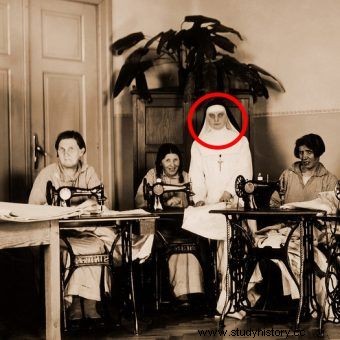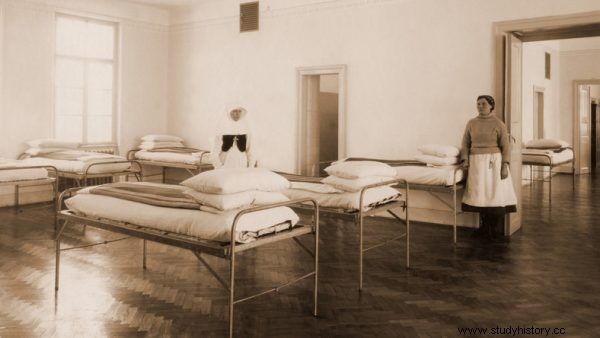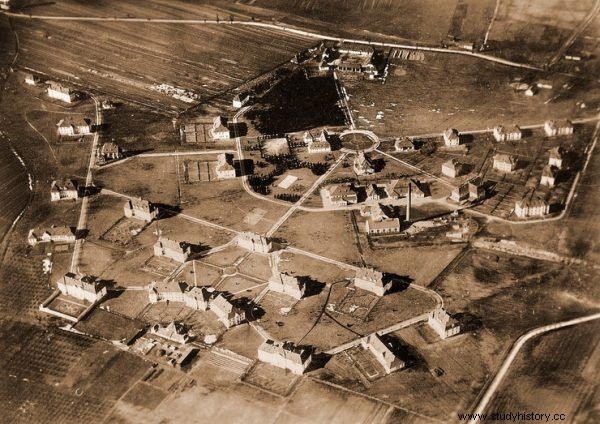Janina hesitated, "not sure if she should mention it." But finally she did. And that's with details.
"It was different here half a century ago, not as quiet as it is today." These words start the story of a nurse who knew Kobierzyn better than anyone else. She spent almost her entire life in an institution for the mentally ill in Kraków. She was employed there as early as 1935, doing "the most strenuous jobs". Half a century later, she could still be found in the corridors of the hospital, which was troubled by the painful history.

Occupational therapy. The photo shows a nun performing a nursing service and a group of patients. Photograph from the interwar period.
It was the 1980s and the nurse decided to tell her story to the local journalist and biographer, Krystyna Różnowska. Her confessions have just appeared on the pages of the book - "You can go crazy. The peculiar world of a psychiatric hospital ” .
Janina Sroka's account touches almost every aspect of the hospital's functioning. He writes about his staff, the life of the plant employees, the fate of patients before the war, during it and in the years of the People's Republic of Poland. However, her memories of old methods of treatment are particularly intriguing. After all, these are the years when there were no psychotropics, no modern medicine. At the same time, however, in Kobierzyn ... there were also no bars on the windows. In order not to stress patients with strained nerves.
In those days, the mentally ill were ashamed, relatives hid them from people, sometimes locked them. There were times when they kept them in a stable, in a cage or in a shed, like animals. The sick were brought to us in terrible condition, emaciated, dirty, with lice.

Hospital room in Kobierzyn. Pre-war photo.

A bird's eye view of the Kobierzyn Hospital. Pre-war photography.
To calm them down, you poured hot water into the bathtub in the bathroom and kept them there for hours, watching over them all the time. Thermometers framed in wood showed the temperature of the water, when it was already cool, warm water was added.
It was the only way to deal with patients in a frenzy at the time. Imagine three or four sick people in bathtubs, splashing water with their hands and feet. How to deal with them?
Janina emphasized that it was forbidden to beat the hospital patients. "For that, people were dismissed from work." At the same time, however, the staff had almost no resources at their disposal to deal with particularly anxious patients.
Before the war in Kobierzyn straitjackets were not used . In turn, the belts used to tie patients to the beds appeared only before the outbreak of the war.
With their help, the therapy was effective, raising doubts not only in terms of effectiveness, but also in ethics. And it was while talking about this method that the nurse hesitated to reveal a compromising detail.
The way was:
(...) calming the sick person with wet sheets wrapped around him like a mummy and left for two hours under pillows to keep him from catching a cold.
Salt was sometimes sprinkled on the sheet. (...) I think that this is not the way of dealing with the sick, salt burns the body, causes pain, but when we did not cope with them, this method was also resorted to.
The nurse assured that the method was used in secret, that it was not a sanctioned method of "treatment." But it was also reached by… one of the hospital doctors. And Janina Sroka herself did not hide that "the sick can be very troublesome, sometimes even dangerous". And that not everyone who takes care of them is able to show enough patience. And with the right amount of understanding.
Source:
Trivia is the essence of our website. Short materials devoted to interesting anecdotes, surprising details from the past, strange news from the old press. Reading that will take you no more than 3 minutes, based on single sources. This particular material is based on:
- Krystyna Różnowska, You can go crazy. The peculiar world of the hospital psychiatric , WAM Publishing House, Krakow 2017.
